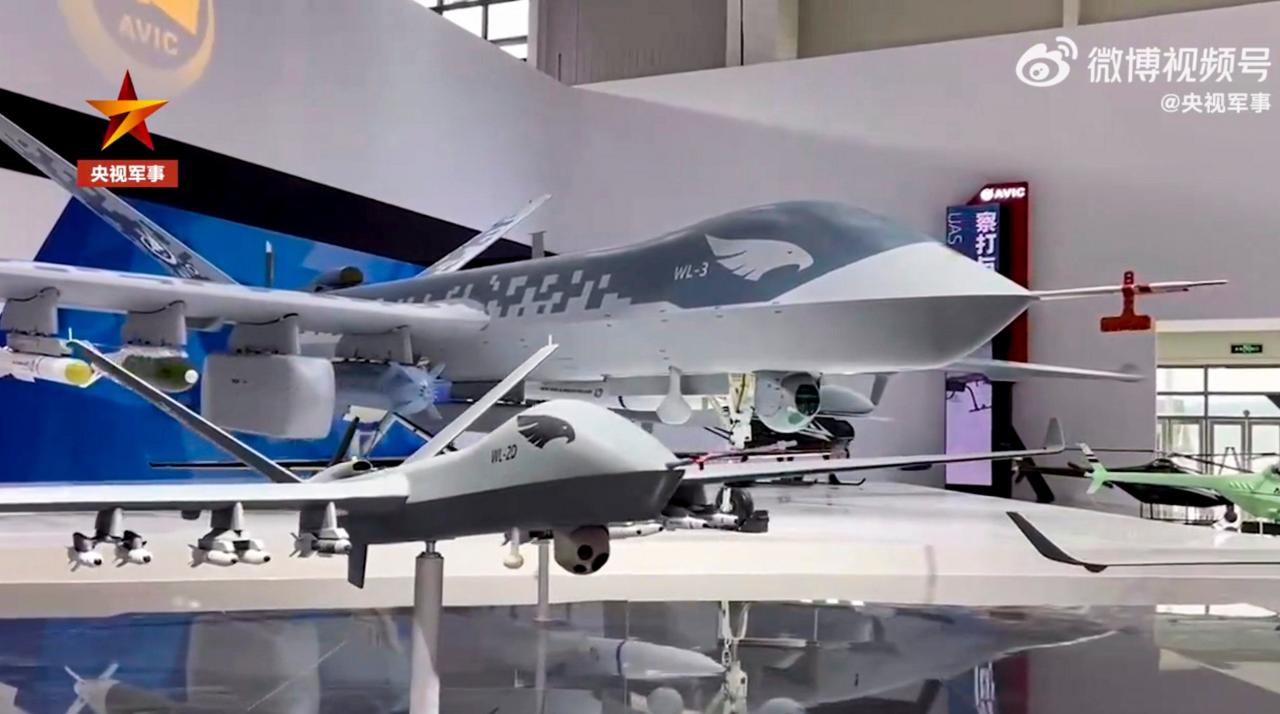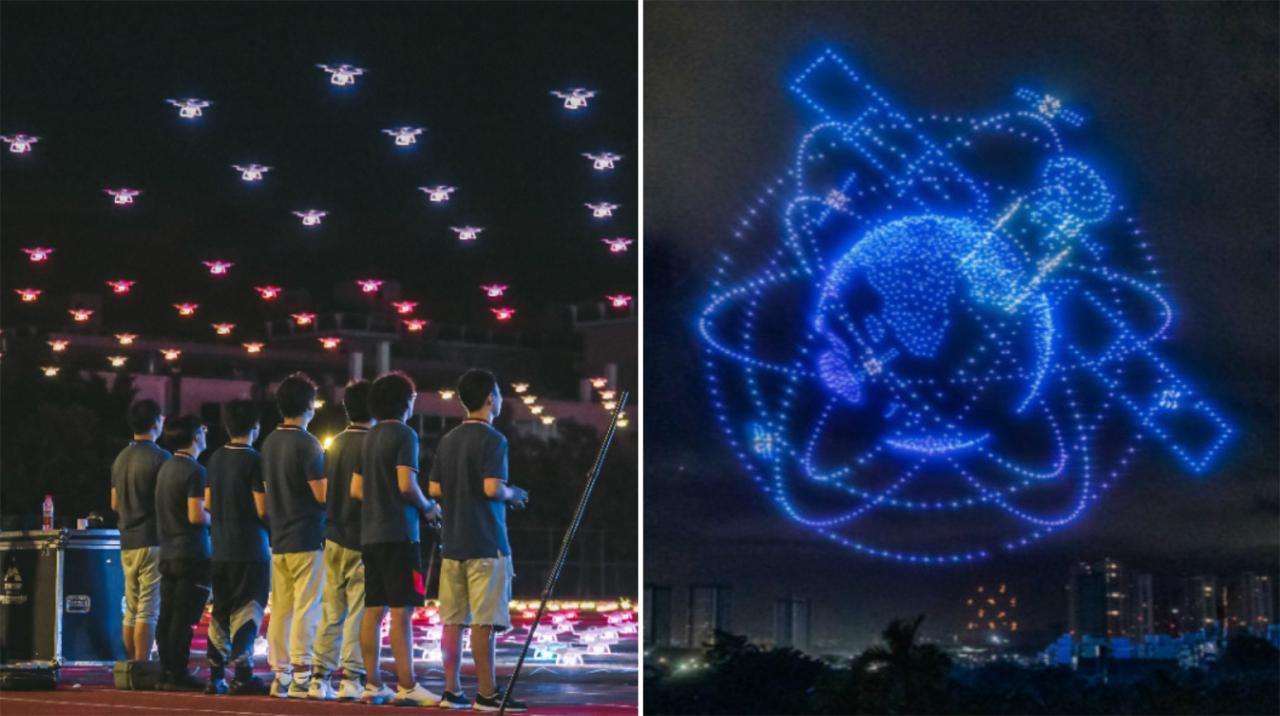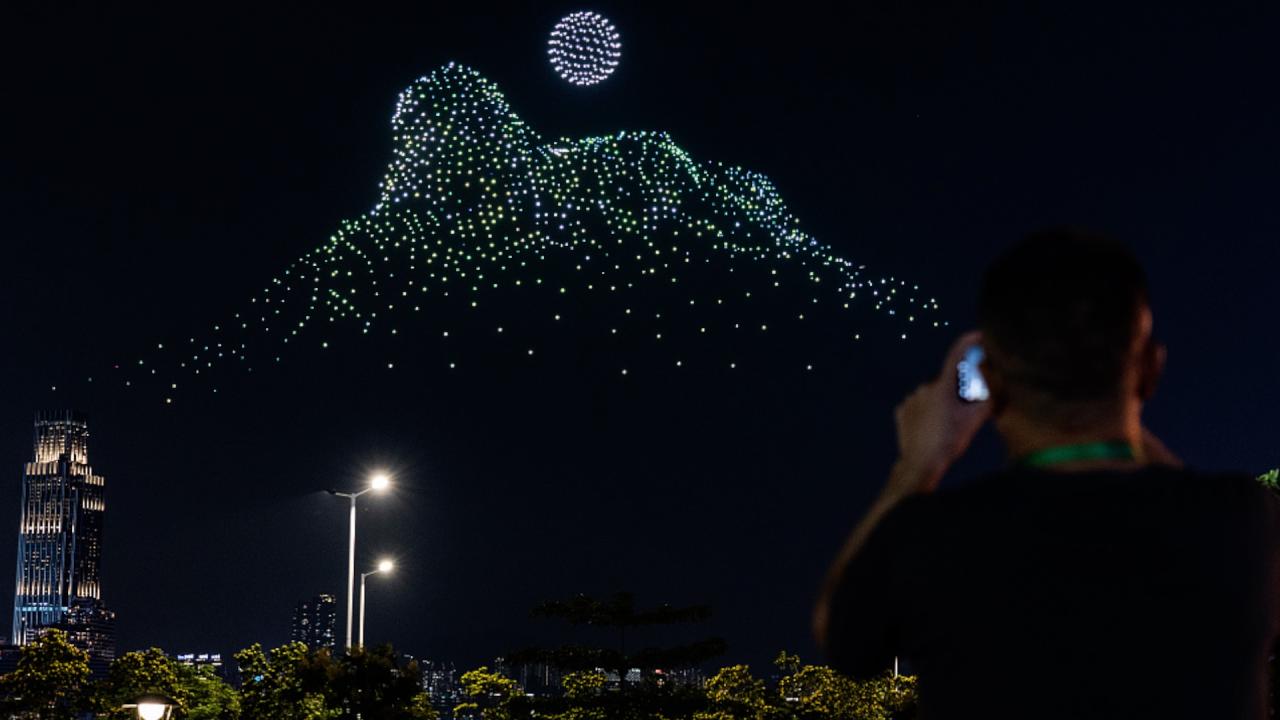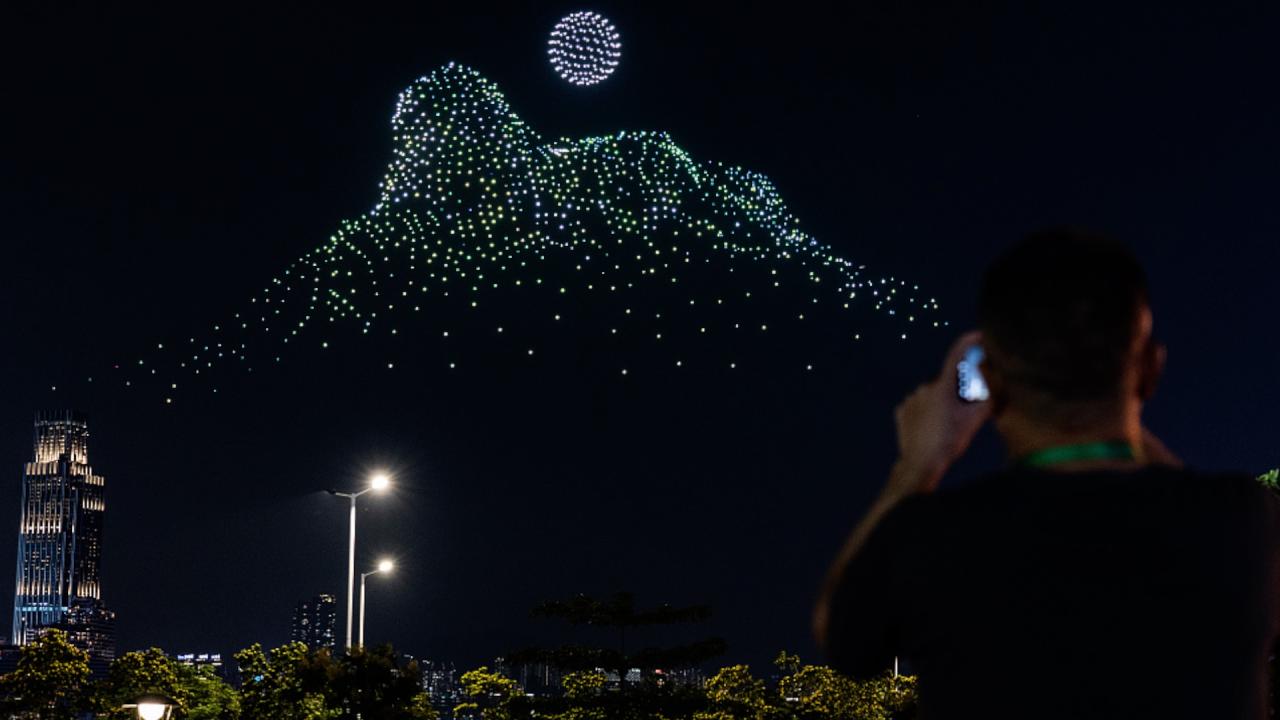China Drone Show 2039: Imagine a future where dazzling drone light shows paint the night sky over bustling Chinese cities, a testament to the nation’s technological prowess. This isn’t science fiction; it’s a projection of China’s rapid advancements in drone technology, poised to revolutionize various sectors by 2039. From autonomous agricultural drones boosting food production to sophisticated surveillance systems enhancing security, the impact will be profound.
This exploration delves into the projected capabilities of Chinese drones in 2039, examining advancements in flight time, payload capacity, and AI integration. We’ll also consider the societal and environmental implications of widespread drone use, the regulatory landscape, and China’s role in international drone technology collaboration and competition. Get ready for a fascinating look at a future shaped by the rise of drones in China.
Technological Advancements in Chinese Drone Technology by 2039
By 2039, Chinese drone technology is projected to undergo a significant transformation, driven by advancements in AI, materials science, and miniaturization. This progress will impact flight capabilities, payload capacity, and autonomous navigation, leading to a wider range of applications across various sectors.
Projected Advancements in Drone Technology
We can expect substantial improvements in flight time, potentially exceeding 10 hours for larger commercial drones and several hours for smaller consumer models. Payload capacity will also increase dramatically, allowing drones to carry heavier equipment and larger quantities of goods. Autonomous navigation systems will be far more sophisticated, enabling drones to operate safely and effectively in complex environments with minimal human intervention.
This will involve improved obstacle avoidance, real-time path planning, and enhanced resilience to GPS interference.
AI and Machine Learning Integration

AI and machine learning will be deeply integrated into Chinese drone systems by 2039. Drones will be capable of advanced object recognition, predictive maintenance, and autonomous decision-making. This will enhance safety, efficiency, and the overall effectiveness of drone operations. For instance, AI could enable drones to identify and avoid obstacles dynamically, adapt to changing weather conditions, and even perform complex tasks like precision agriculture or infrastructure inspections with minimal human input.
Imagine the China Drone Show 2039: a breathtaking spectacle of light and technology. To get a sense of the scale and artistry involved, check out this amazing chinese new year drone show – it’s a smaller event, but it showcases the incredible possibilities. Think of that, but multiplied tenfold for the 2039 show; it’s going to be epic!
Comparison with Global Leading Drone Technologies
By 2039, Chinese drone technology is expected to be among the world’s leading technologies, potentially surpassing some current global leaders in specific areas like AI-powered autonomy and swarm technology. While some Western companies might still hold an edge in certain niche markets, Chinese manufacturers are likely to be highly competitive in terms of price, performance, and overall system integration. The focus on domestic production and rapid technological advancement will be key factors in this competitive landscape.
Projected Drone Specifications in 2039, China drone show 2039
| Drone Type | Flight Time (hours) | Payload Capacity (kg) | Max Speed (km/h) |
|---|---|---|---|
| Consumer | 4-6 | 2-5 | 80-100 |
| Commercial | 8-12 | 10-50 | 120-150 |
| Military | 12+ | 50+ | 200+ |
Potential Applications of Drones in China by 2039
The widespread adoption of drones in China by 2039 will transform various sectors, creating both opportunities and challenges. Their versatility will make them indispensable tools across diverse industries, impacting the economy and job market significantly.
Projected Drone Use Across Sectors
In agriculture, drones will be used for precision spraying, crop monitoring, and automated harvesting. Logistics will see a surge in drone delivery services, especially in remote areas. Infrastructure inspection will become significantly more efficient and safer with drones performing routine checks on bridges, power lines, and pipelines. Surveillance and security will also leverage drone technology for monitoring large areas and enhancing public safety.
The integration of AI and machine learning will enhance the capabilities and efficiency of these applications.
Impact on Chinese Economy and Job Market

The widespread adoption of drones will likely boost China’s economy by increasing efficiency, reducing costs, and creating new job opportunities in drone manufacturing, operation, maintenance, and related services. However, it could also lead to job displacement in some traditional sectors, necessitating workforce retraining and adaptation. The net economic and employment impact will depend on the pace of adoption, government policies, and the ability of the workforce to adapt to the changing landscape.
Challenges and Obstacles to Widespread Adoption

Potential challenges include the need for robust regulatory frameworks, addressing safety concerns, ensuring cybersecurity, and managing public perception. Infrastructure limitations, such as the lack of sufficient charging stations and reliable communication networks in certain areas, might also hinder widespread adoption. Overcoming these obstacles will require collaborative efforts from government, industry, and research institutions.
Imagine the China Drone Show 2039: thousands of drones painting breathtaking aerial displays. But what about underwater spectacles? That’s where the tech showcased at events like this might inspire future innovations, such as the incredible capabilities of the magura v5 sea drone , which could lead to equally stunning synchronized underwater drone shows alongside the aerial ones in the future.
Think coordinated light shows both above and below the waves at the 2039 event!
Top 5 Most Impactful Drone Applications in China (2039)
- Precision agriculture (crop monitoring, spraying, harvesting)
- Drone delivery services (e-commerce, logistics)
- Infrastructure inspection (bridges, power lines, pipelines)
- Emergency response and disaster relief
- Environmental monitoring (pollution detection, wildlife surveys)
Societal and Environmental Impacts of Drone Shows in China by 2039
Large-scale drone light shows are poised to become a significant part of China’s entertainment and tourism landscape by 2039, offering spectacular visual displays. However, we must also consider the potential environmental consequences of widespread drone use.
Positive Societal Impacts of Drone Light Shows
Drone light shows can significantly boost tourism, attract investment, and enhance the cultural vibrancy of cities. They offer unique and memorable experiences, attracting both domestic and international visitors. These events can become iconic symbols of technological advancement and national pride, fostering a sense of community and shared experience.
Potential Negative Environmental Consequences

Widespread drone use could lead to increased noise pollution, especially during large-scale events like drone light shows. Energy consumption associated with charging and operating numerous drones is another concern. The potential for drone collisions or malfunctions also poses a risk to both people and the environment. Careful planning, regulation, and the development of sustainable technologies are crucial to mitigate these risks.
Hypothetical Drone Light Show Scenario (2039)
Imagine a breathtaking drone light show over the Bund in Shanghai, featuring thousands of drones choreographed to create dynamic, ever-changing patterns and images celebrating Chinese culture and technological innovation. The show would require meticulous planning, including airspace management, power supply, communication networks, and emergency response protocols. Potential challenges might include unexpected weather conditions, technical malfunctions, or security threats.
Descriptive Narrative of a Large-Scale Drone Light Show
As dusk settles over the city, thousands of drones ascend into the night sky, transforming into a mesmerizing canvas of light. Intricate patterns, vibrant colors, and dynamic animations dance across the cityscape, creating an unforgettable spectacle for the hundreds of thousands of spectators below. The drones shift and morph, forming fantastical creatures, iconic landmarks, and breathtaking landscapes, leaving the audience spellbound by the technological marvel unfolding above them.
Regulatory and Safety Aspects of Drone Operations in China by 2039
A robust regulatory framework will be essential for ensuring the safe and responsible operation of drones in China by 2039. This will involve clear guidelines for licensing, airspace management, and safety standards, addressing potential safety concerns proactively.
Likely Regulatory Framework for Drone Operations
By 2039, China is likely to have a comprehensive regulatory framework for drone operations, including licensing requirements for different drone types and operational categories. Airspace management systems will be improved to integrate drones safely into existing air traffic. Strict safety standards will be enforced, covering aspects like drone design, maintenance, and pilot training. This framework will likely incorporate international best practices while reflecting China’s specific needs and priorities.
Potential Safety Concerns Related to Drone Use
Potential safety concerns include mid-air collisions, drone malfunctions, unauthorized drone use, and the potential for drones to be used for malicious purposes. Regulations will need to address these concerns through measures like mandatory registration, remote identification systems, and robust cybersecurity protocols. Effective enforcement mechanisms will be crucial to ensure compliance and minimize risks.
Comparison with Drone Regulations in Other Leading Countries
China’s drone regulations by 2039 are likely to be comparable to those of other leading countries in terms of their comprehensiveness and stringency. However, there might be some differences in specific approaches and enforcement mechanisms, reflecting the unique characteristics of China’s airspace and regulatory environment. International collaboration and information sharing will play a key role in shaping these regulations.
Key Regulations for Drone Operation in China’s Airspace (2039)
| Regulation Area | Specific Requirement | Penalty for Violation | Enforcement Agency |
|---|---|---|---|
| Licensing | Mandatory licensing for all commercial and some consumer drones | Fines, suspension of license, legal action | Civil Aviation Administration of China (CAAC) |
| Airspace Management | Designated drone flight corridors and restricted airspace | Fines, flight restrictions | CAAC, local authorities |
| Safety Standards | Mandatory safety checks, pilot training, and maintenance protocols | Fines, grounding of drones | CAAC, manufacturers |
| Data Security | Strict data encryption and transmission protocols | Fines, legal action | Ministry of Public Security, CAAC |
International Collaboration and Competition in Drone Technology by 2039 (China Focus)
China’s advancements in drone technology will likely lead to increased international collaboration and competition. The country will seek to leverage its expertise while facing competition from other global players in this rapidly evolving field.
Thinking about China’s drone show spectacle in 2039? To get a feel for the incredible scale and artistry involved, check out past performances, like this amazing display of coordinated drones: china new year’s drone show. These past shows give you a glimpse into the technological advancements that will undoubtedly make the 2039 show even more breathtaking.
Imagine the possibilities!
Integration of Chinese Drone Technology into International Collaborations
China might participate in international collaborations on drone standardization, safety protocols, and airspace management. Joint research projects focusing on AI-powered drones, swarm technology, and sustainable drone operations are also possible. This could involve collaborations with research institutions and companies in other countries, particularly those in Asia, Europe, and potentially even the Americas, depending on geopolitical factors.
Areas of International Competition
International competition will likely center on market share, technological leadership, and the development of advanced drone applications. This could involve competition in areas such as AI-powered autonomy, swarm technology, drone delivery systems, and military drone capabilities. The competition will be fierce, driven by the significant economic and strategic implications of drone technology.
Comparison of Technological Capabilities
By 2039, Chinese drone technology will likely be comparable to or even surpass that of other leading nations in certain areas, particularly in terms of mass production, cost-effectiveness, and AI-powered features. However, some countries might still maintain an edge in specific niche markets or advanced military applications. The competitive landscape will be dynamic and constantly evolving.
Top 3 International Collaborations China is Likely to Pursue
- Joint research projects on AI-powered drone autonomy with European and Asian partners.
- Collaboration on drone standardization and safety protocols with international organizations like ICAO.
- Development of drone delivery infrastructure and logistics systems with countries in Southeast Asia and Africa.
Wrap-Up
By 2039, China’s drone industry is set to be a global powerhouse, influencing everything from agriculture and logistics to entertainment and national security. The advancements we’ve discussed—from extended flight times and AI integration to sophisticated light shows—represent not just technological progress, but a significant shift in how China operates and interacts with the world. The challenges, from regulation to environmental concerns, are substantial, but the potential rewards are even greater.
The China Drone Show of 2039 is more than just a spectacle; it’s a symbol of a future reshaped by innovation and ambition.
Top FAQs: China Drone Show 2039
Will all drones in China be autonomous by 2039?
No, while autonomous capabilities will significantly improve, fully autonomous operation for all drone types isn’t likely by 2039. Human oversight will remain crucial, especially in sensitive areas.
What about the cost of these advanced drones?
The cost will vary greatly depending on the type and capabilities of the drone. While some consumer models might become more affordable, highly sophisticated commercial and military drones will likely remain expensive.
What are the job implications of widespread drone use?
Widespread drone adoption could displace some workers in certain sectors, but it’s also likely to create new jobs in drone manufacturing, maintenance, and operation.
How will China manage drone airspace safety?
Expect robust air traffic management systems and strict regulations to prevent collisions and ensure safe operation. Advanced drone identification and tracking technologies will likely play a major role.
